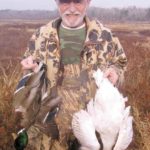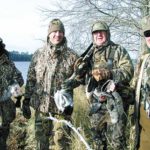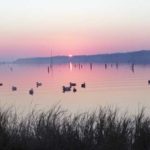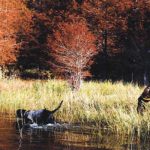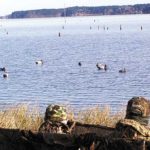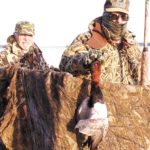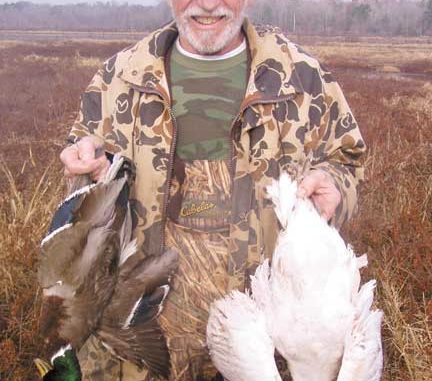
Two of Louisiana’s heavy hitters for springtime spawning bass are also loaded with publicly available ducks this time of year.
Have you ever wished you had a shotgun in your hand rather than a fishing rod while bass fishing on your favorite big-water lake during the winter? I bet it was almost like the ducks flying right over your head could tell that your Carolina-rig rod didn’t pose them any danger at all.
Stephen Johnston has been there. Johnston moved from Port Arthur, Texas, to Toledo Bend in 1989 to become a full-time fishing guide, but he and his customers usually got very distracted by ducks during winter. It got to the point that many of his customers started talking to him about doing some duck hunts rather than fishing trips.
“I had done a little hunting on my own up until about 1990,” Johnston said, “so I knew the ins and outs of hunting the lake. I wound up telling these folks to just come back up for a couple fun hunts as a way of saying ‘thank you’ for their business. By 1994, these initial trips turned into a full-blown guide service.”
During his early years guiding for ducks on Toledo Bend, Johnston found the hunting to be fantastic. In fact, he says it was hard to tell the difference between opening day and the close of the season. For him, every day was like opening day.
“As much as I hate to say it,” Johnston said, “the last three or four years haven’t been that great. It’s no big secret that hydrilla is the big (food source) at Toledo Bend, and with the lack of grass that we had the past few years, it really knocked back the duck hunting.”
That doesn’t look to be the case at Toledo Bend this year. Johnston says there is more hydrilla in the lake this year than the last four years. One of the primary reasons for the lack of grass recently was the up and down water levels on the lake. Relatively stable water this year has the grass growing well again.
While duck hunting at Toledo Bend may have had a few off years recently, the same can’t be said for Lake D’Arbonne in Farmerville. According to Simsboro resident Sid Havard, who hunts D’Arbonne frequently every season with his son and friends, duck hunting has been pretty good the past couple of years.
“The best day we had last year was 14 ducks,” Havard recalled. “It was a mix of wood ducks, mallards and teal. We were running up one of the creeks, but we had to come down and idle because of some thick fog. While we were idling, I thought I heard some ducks. Sure enough, we turned the motor off, and we could hear them.”
Havard pushed his boat back into the pocket, and he was able to see through the breaks in the fog that the pocket was “tee-totally” full of ducks.
Before sunrise the next morning, Havard and his group were situated in the pocket. The ducks never even knew what hit them.
The example of Havard finding ducks one afternoon and shooting them the next morning is one of the most important factors big-lake hunters should consider. In fact, Johnston says hunters who try to scout the weekend before a hunt will be sorely disappointed a week later.
“Scout the day before you hunt,” he instructed. “Don’t even worry about what the ducks are doing the weekend before because you can bet they’re going to be doing something different when you come back. I think this is one of the main things that frustrates so many hunters when they try hunting a big lake.”
The main reason for scouting the day before a hunt is because the wind direction should generally be from the same direction within a 24-hour period unless a cold front is blowing through. And the wind direction is the primary factor for determining where ducks will be on a big lake.
“Let’s say I’ve been hunting birds on a south bank before a front,” Johnston said. “As those strong south winds start picking up, the southern bank is the lee bank because the wind is blowing right over the tops of the trees.
“After the front blows through and it switches to a north wind, there will be 2-foot waves crashing that same southern bank. That means the ducks are going to pick up and move to wherever they can find food on a northern bank.”
At Toledo Bend, that might mean moving to an entirely different cove or even a different creek, depending on how the grass flats are positioned. Many of the coves and creeks here have a flat side and a deep side, so simply jumping to the other side may not be doable.
Changing wind can also move the food as much as it moves the ducks. In fact, at Lake D’Arbonne, Havard says moving food is what makes the ducks move.
“We usually have a lot of that clover-leaf duckweed up here that gathers in the pockets,” he explained. “If we have a south wind, it will push it into the northern pockets. Well, once the wind switches and starts blowing from the north, it can literally move that duckweed to the southern pockets overnight. Since this stuff is like candy to a duck, you can bet duck locations can change just as quickly.”
Other than taking the wind direction and food location into consideration, Johnston says the general rule of thumb when hunting big water is to hunt the open-water flats when the wind is calm, and move to the creeks when the wind starts picking up.
“I’ve got some floating blinds that I pull around to the different main-lake flats,” he said. “And we hunt those unless the wind is too strong. If we’re forced back into the creeks, I use either my 14-foot or 21-foot aluminum boats to maneuver around in the creeks.
“While I love hunting out of the floater, the versatility of hunting from boat blinds is great. In fact, a lot of times we just use the boats to reach a feeding flat. Then we get out and do our best to look like a stump.”
The variety of ducks that like to call Toledo Bend home during the winter is another reason hunters are attracted to the big water. Wigeon, gadwall and mallards are typically found in the creeks, while the open water is usually populated by canvasbacks, redheads, buffleheads and blackjacks.
If the wind will allow, Johnston said mallards and wigeon would work the main lake, too.
Duck species on D’Arbonne are very similar to Toledo Bend without the canvasback and redheads. The lake is home to good numbers of mallards, gadwall, wood ducks, teal and blackjacks after the migration has made its way to North Louisiana.
With so much water at both lakes, it’s often confusing to try to figure out exactly where to hunt. That’s why scouting the day before is so important. However, Johnston and Havard pointed out a couple of places where hunters can have a reasonable chance of seeing and shooting ducks.
“The Indian Mounds on the Texas side is good at Toledo Bend,” Johnston said. “That area has a lot of big flats, open water and creek hunting. On the Louisiana side, I would have to go with Toro Bay. It has a lot of grass and some big flats, and there are always good numbers of birds hanging out in that area.”
Havard pointed out Boatwright Creek at the very far reaches of Corney Creek as being one of the most productive spots on D’Arbonne when grass is present.
“There are a ton of ducks up there feeding on that grass when it’s there,” he said. “If the grass isn’t there, though, you won’t see that many ducks.”
If you’re out trying to catch a bass this winter and you can’t help but notice the ducks are thumbing their noses at you, put down your rod and go see where they’re going.
Trade in your Carolina-rig rod for a shotgun the next morning, and you’ll find out there are more than big bass at big lakes. Big lakes are also full of big ducks.
Contact Stephen Johnston at 409-579-4213 or www.johnstonfishing.com.
